BAKTRIA
The Bactrian kingdom was the easternmost of the Hellenistic Greek kingdoms of the successors of Alexander the Great. It originated around 256 BC when Diodotus I declared himself independent of the Seleukid king Antiochos II. Map at maximum extent. The coins of the Graeco-Bactrian period preserve the finest in Hellenistic portraiture.
DIODOTUS I, c. 256-239 BC
|
11519. BAKTRIA, KINGS, DIODOTOS II THEOS, Circa 250-240 BC. AR Tetradrachm (27mm, 16.98 g, 6h). Mint A. Struck circa 239/8-230 BC. Diademed head of Diodotos I right / Zeus Bremetes advancing left, brandishing thunderbolt, aegis on outstretched arm; to left, monogram above eagle standing left. Kritt D8; Bopearachchi 6F; SNG ANS -. Fine, rough surfaces. Rare. | 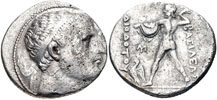 |
DIODOTUS II, c. 256-230 BC (uncertain if there are any actual portrait coins of Diodotos II)
|
11519. BAKTRIA, KINGS, DIODOTOS II THEOS, Circa 250-240 BC. AR Tetradrachm (27mm, 16.98 g, 6h). Mint A. Struck circa 239/8-230 BC. Diademed head of Diodotos I right / Zeus Bremetes advancing left, brandishing thunderbolt, aegis on outstretched arm; to left, monogram above eagle standing left. Kritt D8; Bopearachchi 6F; SNG ANS -. Fine, rough surfaces. Rare. |  |
ANTIOCHOS NIKATOR, c. 240-225 BC
|
11517. BAKTRIA, KINGS, ANTIOCHOS NIKATOR, Circa 240-225 BC. AR Tetradrachm (27mm, 16.56 g, 5h). Attic standard. Mint A (near A• Khanoum). Diademed head right / Zeus Bremetes advancing left, brandishing aegis and thunderbolt; to inner left, monogram above eagle standing left. Holt Series A, Group 6 (Diodotos II); Bopearachchi Serie 2E (Diodotos II); SNG ANS 77-8 (Diodotos II). VF, toned. Rare. Excellent sensitive portrait. Provenance: Ex Classical Numismatic Group XXIII (13 October 1992), lot 277.
According to the traditional chronology of the early Baktrian kings, Diodotos I attempted to gradually secede from the Seleukids. This stands in stark contrast to all other separatists and usurpers of the time. As a part of his slow transition, he first issued coins bearing the name of Antiochos, and only later struck in his own name. Jakobsson (NC 2010, pp. 17-33) refutes this model and reassigns these "transitional" issues from Diodotos to a new King Antiochos in Baktria. His argument rests on three main points: the existence of a commemorative tetradrachm of Agathokles that names an Antiochos Nikator; a new arrangement of the control marks and links between the coinage of Diodotos II, "Antiochos," and Euthydemos; and the generally overcomplicated nature of the earlier models of Holt and Kritt. According to the new chronology, Diodotos I swiftly broke from the Seleukids and struck coinage in his own name. He was succeeded by Diodotos II, then Antiochos Nikator, who both continued with the same dynastic type of Zeus Bremetes. �Commentary courtesy CNG. | 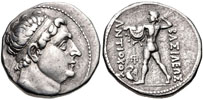 |
EUTHYDEMOS I, c. 230-190 BC
|
10741. BAKTRIA, KINGS, EUTHYDEMOS I, Greco-Baktrian Kingdom. Circa 225-200 BC. AR Tetradrachm (29mm, 16.63 g, 12h). Mint B. Struck circa 215-208/6 BC. Diademed middle-aged head right / Herakles seated left on rock, holding club set on rocks; PK monogram to lower inner right. Kritt B14; Bopearachchi SŽrie 9A; ANS 136. VF, toned, light porosity. Choice bold portrait. Perfectly centered. | 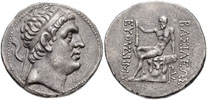 |
DEMETRIOS I, c. 205-171 BC
|
11317. KINGS of BAKTRIA, GRECO-BAKTRIAN KINGS. DEMETRIOS I. c. 200-190 BC. AR Tetradrachm (16.07g). Diademed, draped bust right of Demetrios, wearing elephant headdress. Reverse: Young Herakles standing facing, crowning himself, holding club in left hand; lion-skin draped over forearm; to left, monogram. Bopearachchi Serie 1C; SNG ANS 187. Areas of light porosity. Choice Very Fine. Provenance: Ex Palladium 8, 7 April 1995, lot 87; The Joseph Melchione Collection.
SOLD.
| 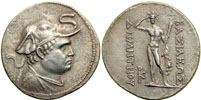 |
|
10433. KINGS of BAKTRIA, GRECO-BAKTRIAN KINGS. DEMETRIOS I. Circa 200-185 BC. AE Triple Unit (30mm, 12.54 g, 12h). Head of elephant right, wearing bell around neck / Kerykeion; monogram to inner left. Bopearachchi Serie 5E; SNG ANS 209-211. EF, dark brown patina, slight double striking, very minor smoothing. Superb example.
SOLD. | 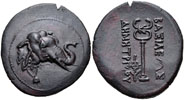 |
EUTHYDEMOS II, c. 190-171 BC
|
11262. KINGS of BAKTRIA, GRECO-BAKTRIAN KINGS, EUTHYDEMOS II. Circa 185-180 BC. AR Tetradrachm (29mm, 16.34 g, 11h). Attic standard. Diademed and draped bust right / Herakles standing facing, holding wreath and cradling club in arm draped with lion skin; monogram to inner left. Bopearachchi 1C; SNG ANS 216. VF, toned, a number of scrapes and scratches.
| 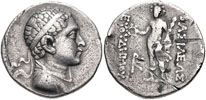 |
DEMETRIOS II, c. 175-170? or 145-140? BC, (distinguished by Pallas Athena rather than Herakles on the reverse)
ANTIMACHOS I, c. 171-160 BC
|
10851. KINGS of BAKTRIA, GRECO-BAKTRIAN KINGS, ANTIMACHOS I THEOS. Circa 180-170 BC. AR Tetradrachm (34mm, 16.75 g, 1h). Diademed and draped bust right, wearing kausia / Poseidon standing facing, holding trident and filleted palm; monogram to inner right. Bopearachchi Serie 1A; SNG ANS 274-5. Good VF, surface marks. Fine style portrait. | 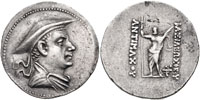 |
AGATHOKLES I, c. 171-160 BC
|
11385. KINGS of BAKTRIA, GRECO-BAKTRIAN KINGS, AGATHOKLES I. 171-160, Tetradrachm, Merv mint. Diademed and draped bust right in high relief. Reverse: Zeus standing facing holding a long staff in his left hand, holding in his right hand Hecate with 2 flaming torches. MIG 137a. 16.46g, Provenance: Ex Generation Collection I (Hirsch 275 Lot No. 4113). Acquired 1996 at Athena in Munich. Beilagzettel with the collector. Good VF; a very fine style Hellenistic portrait.
Agathokles was co-ruler with Antimachus who had to defend himself as a member of the old royal family against the usurper Eukratides. In this context, the famous family imprints of both kings are seen, which their ancestors traced back to Alexander the Great to establish their legitimacy as rulers. Ultimately, however, they lost to Eukratides. SOLD.
| 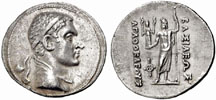
|
PANTALEON, c. 171-160 BC
HELIOKLES and LAODIKE, father and mother of Eukratides I
EUKRATIDES I, c. 171-135 BC
|
11318. BACTRIAN KINGS, EUKRATIDES I, c. 170-145 BC. AR Tetradrachm (16.86g). Diademed heroic style bust seen from behind, head left, of Eukratides, wearing crested helmet adorned with bull's ear and horn, brandishing javelin in right hand. Reverse: Dioscuri riding right, each holding spear and palm branch; below horses' raised forelegs, monogram. Bopearachchi Serie 8B; SNG ANS 485. A few minor marks. Choice Very Fine. One of the most artistically beautiful of ancient Greek coins and a much superior example of style of the type.
Provenance: Ex Palladium 11, 5 April 1996, lot 160; The Joseph Melchione Collection. | 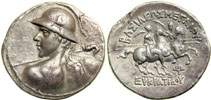 |
PLATO, c. 150 BC
APOLLODOTUS I, c. 160-150 BC
ZOILOS I, c. 150-145 BC
EUKRATIDES II, c. 145-140 BC
|
10852. KINGS of BAKTRIA, GRECO-BAKTRIAN KINGS, EUKRATIDES II SOTER. Circa 145-140 BC. AR Tetradrachm (31mm, 16.79 g, 11h). Diademed and draped bust right / Apollo standing left, holding arrow and grounded bow. Bopearachchi Serie 1H; SNG ANS 619-22. VF, a bit porous. Fine style portrait. | 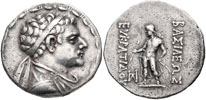 |
LYSIAS, c. 145-135 BC
ANTIALKIDAS, c. 145-135 BC
HELIOKLES I, c. 135-110 BC
|
11146. BACTRIAN KINGS, HELIOKLES DIKAIOS. Circa 145-130 BC. AR Tetradrachm (31mm, 16.71 g, 11h). Attic standard. Diademed and draped bust right / Zeus standing facing, holding winged thunderbolt and scepter; monogram to inner left. Bopearachchi 1U; SNG ANS 642. VF, lightly toned, two small bumps before nose, occasional light scratch. | 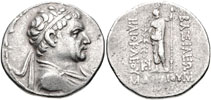 |
POLYXENOS, c. 135-130 BC
EPANDER, c. 135-130 BC
STRATO I, c. 130-110 BC
PHILOXENOS, c. 110-80 BC
DIOMEDES, c. 110-80 BC
APOLLODOTOS II, c. 110-80 BC
ARCHEBIOS, c. 80-60 BC
PEUKOLAUS, c. 80-60 BC
THEOPHILOS I, c. 80-60 BC
CHARACENE
|
10222. CHARACENE, CHARACENIAN KINGDOM, ATTAMBELOS I. 47/6-25/4 B.C. BI tetradrachm (30 mm, 12.30 g, 12 h). Charax-Spasinu, S.E. 269 (47/6 B.C.) Diademed head of Attambelos I right / [B]ASILE[WS] ATTA,BJ[LOS] SWTHPO[S KA]I EYE[PGETOY], Herakles seated left on rocks, resting club on his knee; in inner left field above, monogram; above knee, P; in exergue, date ([thXS]) . Hill 10-11; Alram -. VF, lightly toned, crudely struck as issued. Ex: Pars Coins.
| 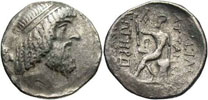 |
COMMAGENE
|
10221. COMMAGENE, COMMAGENIAN KINGDOM, ANTIOCHOS IV, EPIPHANES. A.D. 38-72. AE 26 mm (12.55 g, 12 h).
BACILEYC M-EG ANTIOXOC EPI, diademed head of Antiochos IV right; c/m: uncertain / KOMMA-GENON, scorpion within wreath. RPC 3856; BMC 4-5. VF, dark olive-green patina. Ex: Dr. Martina Dieterle. | 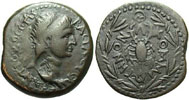 |
|
11340. COMMAGENE, COMMAGENIAN KINGDOM, IOTAPE (38 - 72 AD).
AE, Laranda (?) In Lycaonia. 17.92 g. Bust of Iotape right, anchor countermark before neck; BACILICA IWTAPH FILADELFOS. Rs: Scorpion within wreath; KOMMAG-HNWN. RPC 3534, ECR Lindgren 1887, Howgego 372. Extremely rare. Brown-green patina. Very nice example much superior to most with an excellent portrait. | 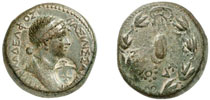 |
CYPRUS
|
10409. CYPRUS, UNCERTAIN MINT, TIME OF AUGUSTUS, 27 BC-AD 14. AE 17 mm. Obverse: Capricorn to right; above, six-rayed star. Reverse: Scorpion; above, six-rayed star. Amandry, Julio-Claudien I, Group 6; RPC 3916 and Suppl. 3916 note (Cyprus); Parks 7; BMC 4 (Commagene). VF. Rare astrological issue.
Although the time this issue was struck is uncertain, the presence of the capricorn suggests a striking under Augustus. This type was previously attributed to Commagene (and still is by a small minority), but finds on the island and the housing of 24 specimens in the Nicosia Museum point to a Cypriot origin. | 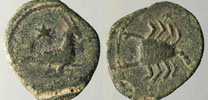 |
INDO-GREEK
MENANDER, c. 160-145 BC
|
10880. KINGS of BAKTRIA, INDO-GREEK KINGDOM, MENANDER I SOTER. Circa 155-130 BC. AR Tetradrachm (24mm, 9.93 g, 11h). Indian standard. Diademed and draped bust right / Athena Alkidemos left; Σ to left, monogram to right. Bopearachchi Serie 12A; SNG ANS 764-7. Good VF, light porosity. | 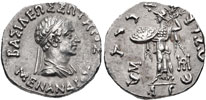 |
INDO-SCYTHIAN
JUDAEA
PARTHIA
|
11440. PARTHIA, KINGS, MITHRADATES II. 121-91 BC. AR Tetradrachm (30mm, 16.18 g, 12h). Seleukeia on the Tigris mint. Struck circa 119-109 BC. Diademed bust left / Archer (Arsakes I) seated right on omphalos, holding bow; palm branch to outer right, TV in exergue. Sellwood 24.4; Shore 67; Sunrise 284. Near EF, lustrous, areas of weak strike. Good metal. Excellent Hellenistic style portrait.
SOLD.
| 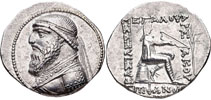 |
PERSIA
|
7539. A CHOICE GOLD DARIC OF THE PERSIANS, Circa 450-330 BC.
After the defeat of King Croesus of Lydia, Asia Minor and its Greek cities fell under Persian control leading to more than two centuries of warfare between the Greeks and Persians. These struggles have become legendary thanks to the ancient historians' accounts of the Spartan defense of Marathon, the Persian sack of Athens, and the final defeat of the Persian fleet at Salamis. Throughout this period the Persians issued a series of gold and silver coins including this gold daric of circa 450-330 BC, the period of Kings Artaxerxes I to Darius III.
This gold daric is a choice example of the Persian coinage of this period, as many of the surviving examples are in poor condition or with portions of the figure off the flan. This is one of the rare examples where the figure of the Great King is all present, in excellent condition and well centered on a symmetrical flan. Certainly a choice example of numismatic art from ancient times and one that is directly associated with these historic events. Obverse: Figure of the Great Persian King wearing crown and long robe. He runs right carrying a bow and spear, a quiver of arrows protruding behind him. Reverse: Irregular punch mark of rectangular form. Dimensions: 17 x 14.5 mm. (0.67 x 0.57"). Weight: 8.32 gm. (0.260 Troy oz.). Metal composition: Nearly pure gold. References: Babelon, pl. 86, 19-21. Grade: Extra Fine.
SOLD. |
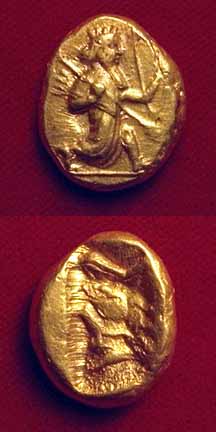 |
|
10274. PERSIA, ACHAEMENID KINGS. 375-340 BC, Siglos, 5.42g. Type IV C. Carradice-46ff. Obv: Kneeling running king with bow and dagger, Rx: Irregular incuse. Rare type with no quiver over king's right shoulder as there typically is. Ex Gorney & Mosch 181, 12 October 2009, lot 1574. Ex. Harlan Berk. Exceptionally nice for these, even the buttons on the king's garment are sharp. EF. | 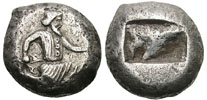 |
|
9420. CARIA UNDER PERSIAN EMPIRE, SATRAPAL ISSUE, c. 350-334 BC. AR tetradrachm, 20mm. Persian king, wearing kidaris and kandys, in kneeling-running stance right, drawing bow, quiver over shoulder / Satrap, wearing kyrbasia, on horseback right, thrusting spear he holds aloft in his right hand; F. Rare in any condition!
Struck in the last years before Alexander's invasion of the Persian empire, the archer-horseman tetradrachms of Achaemenid Karia are one of the rarest and most enigmatic Persian coinages struck in Asia Minor. We are unfortunately aware neither of where nor why they were produced - no inscription is present to facilitate identification of the issuing authority, with only various symbols and letters present as control marks. These control marks allowed Konuk to discern two distinct series: those with subsidiary symbols, and those without. Analysis of the Pixodarus Hoard has allowed the coinage to be dated from the decade beginning circa 350 BC. Additionally, since that hoard contained only the earlier, non-symbol, type, Meadows concluded that the date of deposit of the hoard (341 BC) should be seen as the earliest possible start of the second series. |
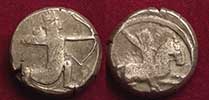
|
PHOENICIA
|
10504. PHOENICIA, ARADOS. Circa 138/7-44/3 BC. AR Tetradrachm (28mm, 14.76 g, 12h). Dated CY 164 (96/5 BC). Veiled, draped, and turreted bust of Tyche right / Nike standing left, holding wreath and palm; ΔΞP (date) before; all within wreath. Duyrat 3249-61 (unlisted obv. die); SNG Copenhagen -; HGC 10, 72. VF. |
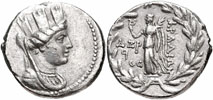 |
|
10883. PHOENICIA, ARADUS, Under Trajan. AD 98-117. AE (12mm, 6.95 g, 12h). Dated CY 365 (AD 106/7). Draped bust of Astarte-Europa right; before, small laureate head of Trajan right / Bull charging left; EΞT (date) above, Phoenician letter before. BMC 368-70. VF, green and brown patina. Choice example.
|

|
|
8581. PHOENICIA, SIDON, BA'ANA, 400-385 BC. AR Double Shekel, 27.96 gm, BMC.7, Betlyon 13. Sidonian war galley before the turretted walls of Sidon, two Persian lions tail to tail below/King of Persia in war chariot, Punic character above, below a ram in incuse with solar disk above reverted head leaping l. VF. Excessively rare. The only other example I've seen for some years, without a test cut, was being offered several years ago at $27,000. This wonderful extra large and heavy silver coin is one of the few that gives us a city view of a major city from ancient times reflecting the height of Phoenician maritime power which enabled the Phoenicians to extend their trading empire across the entire Mediterranean, down the west coast of Africa, up the coast of Europe and perhaps beyond. |
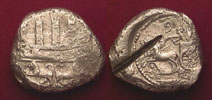 |
|
12854. PHOENICIA, SIDON. Baalshillem (Sakton) II. Circa 401-365 BC. AR Double Shekel (30mm, 27.84 g, 11h). Galley left; Phoenician B above, waves below / Persian king and driver in chariot left; behind, king of Sidon, in Egyptian style garments, holding cultic scepter and votive vase, walking left. E&E-S 557 (D18/R32); Rouvier 1096; Betlyon 18; HGC 10, 236. VF, toned, off center on obverse, area of flat strike on reverse. Good metal for issue. A superior example with all devices much clearer than usual. A wonderful extra large and heavy silver coin from ancient times reflecting the height of Phoenician maritime power which enabled the Phoenicians to extend their trading empire across the entire Mediterranean, down the west coast of Africa, up the coast of Europe and perhaps beyond. |
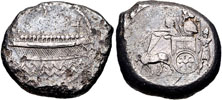 |
|
THE 30 PIECES OF SILVER OF THE BIBLE
8195. PHOENICIA, TYRE, 1st century BC/AD. AR Shekel. Head Melquarth r./Eagle stg. The 30 pieces of silver mentioned as the 30 pieces of silver in the Bible. Toned EF. Excellent example with an especially sharp Melquarth.
SOLD. |
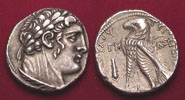 |
|
6549. THE 30 PIECES OF SILVER OF THE BIBLE. PHOENICIA, TYRE. AR Half Shekel. Hd. Melqart l./Eagle stg. r. EF. The actual denomination used for the Jewish temple tax. Better than image.
SOLD.
|
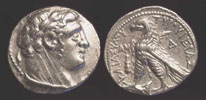 |
SELEUKID KINGS (history, maps, family tree)
SELEUKOS I, NIKATOR, 312-280, successor of Alexander III the Great in Syria
|
11288. SELEUKID KINGS, SELEUKOS I, 312-280 BC. Struck by Antiochos I Soter, 280-261 BC. AR Tetradrachm (15.92 g) minted at Sardes, c. 276-272 BC. Diademed, horned head right of Seleukos I. Reverse: Apollo seated left on omphalos, holding bow. SC 323 2b-c; WSM 1366-7. Impressive and forceful Hellenistic portrait. Near EF and extremely rare and one of the very few portrait coins of Seleukos I, the founder of the Seleukid Kingdom and Dynasty. |
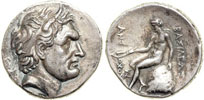
|
ANTIOCHOS I, SOTER, 280-261, son of Seleukos I
|
11013. SELEUKID KINGS OF SYRIA, ANTIOCHOS I SOTER, 281-261 BC. AR Tetradrachm (29mm, 17.10 g, 6h). Seleukeia on the Tigris mint. Diademed head right / Apollo seated left on omphalos, testing arrow, resting hand on bow; monograms to outer left and right. SC 379.2; HGC 9, 128g. Good VF, toned. From the Stephen Glover Collection. A superior style example. | 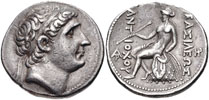 |
ANTIOCHOS II, THEOS, 261-246, son of Antiochos I
|
11014. SELEUKID KINGS OF SYRIA, ANTIOCHOS II THEOS. 261-246 BC. AR Tetradrachm (27mm, 16.88 g, 12h). Tarsos mint. Diademed head right / Apollo seated left on omphalos, testing arrow, resting hand on bow; two monograms in exergue. SC 561; HGC 9, 238n. Good VF, lightly toned, some porosity on the reverse. From the Stephen Glover Collection. Wonderful style portrait. | 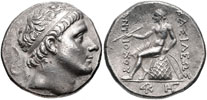 |
LAODIKE I (Laodice I), wife of Antiochos II
|
12958. SELEUKID KINGS, LAODIKE I, wife of Antiochos II. Struck at Laodikeia, Phrygia, AE 18, 2nd century BC. (5.00 g, 18 mm).
Bust of Laodice, the nominal founder of Laodikeia, right / filleted cornucopia; kerykeion to left.
Beautiful dark green patina.
SNG von Aul. 8410; SNG Cop. 501.
| 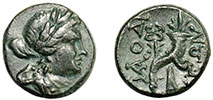 |
SELEUKOS II, KALLINIKOS, 246-226, elder son of Antiochos II and Laodike I
|
8582. SELEUKID KINGS, SELEUKOS II, 246-226 BC. AR Tetradrachm, Sear 6896. His diademed head r./Naked Apollo stg., leaning on tripod sighting an arrow. VF. Of exceptional style both in the sensitive, intelligent head of the ruler and even more so in the superb rendering of Apollo make this coin an exceptional example of Greek numismatic art and far superior in style to the Sear plate coin. |
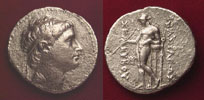 |
|
11015. SELEUKID KINGS, SELEUKOS II KALLINIKOS. 246-225 BC. AE (16mm, 3.01 g, 12h). Mint associated with Antioch. Struck after circa 228 BC. Diademed head right / Pegasos leaping left. SC 712; HGC 9, 352. VF, brown patina. Scarce. From the Stephen Glover Collection. Unusual fully bearded portrait. Choice portrait for these. |
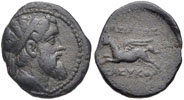 |
ANTIOCHOS HIERAX, 246-227, younger son of Antiochos II and Laodike I
|
OF THE FINEST HELLENISTIC STYLE
11446. SELEUKID KINGS OF SYRIA, ANTIOCHOS HIERAX, 246-227 BC. AR Tetradrachm. Ilion (Troy) mint. Circa 246-227 BC. Diademed head r. / Apollo seated l. on omphalos, holding arrow and bow; owl r. in l. field. SC 869.2; HGC 9, 405f. 17.08g, 32mm, 12h. Good Very Fine. A magnificent Hellenistic portrait of the finest style.
| 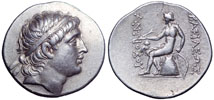 |
SELEUKOS III, KERAUNOS, 226-223, elder son of Seleukos II
|
10996. SELEUCID KINGS OF SYRIA, SELEUKOS III SOTER (KERAUNOS). 225/4-222 BC. AR Tetradrachm (29mm, 16.90 g, 12h). Antioch mint. Diademed head right / Apollo Delphios seated left; monograms to outer left and right. SC 921.1; HGC 9, 414a. VF, metal flaws on portrait. From the Fredy Vortisch Collection.
|
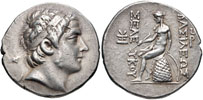 |
ANTIOCHOS III, THE GREAT, 223-187, younger brother of Seleukos III
|
10860. SELEUCID KINGS, ANTIOCHOS III, 223-187 BC. AR Tetradrachm (30mm, 16.34 g, 12h). Antioch mint. Struck circa 204-197 BC. Diademed head right / Apollo Delphios seated left on omphalos, testing arrow, hand on bow; tripod to outer left. SC 1044.2; HGC 9, 447u. VF, surfaces a little rough. |
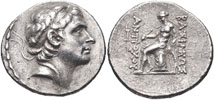 |
MOLON, 222-220. Rebel satrap of Media. No portrait coins, no tetradrachms.
ACHAIOS (ACHAEUS), 220-214, usurper, uncle of Antiochos III
|
11261. SELEUCID KINGS, ACHAIOS. Usurper, 220-214 BC. AE (15mm, 3.17 g, 10h). Sardes mint. Laureate head of Apollo right / Eagle standing right, palm frond over shoulder; A[B?] to right, [uncertain control, if any, in exergue]. Cf. SC 955.1d; HGC 9, 435. Good VF, green-brown patina. |
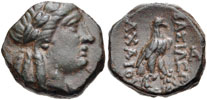 |
SELEUKOS IV, PHILOPATOR, 187-175, elder son of Antiochos III
|
10847. SELEUCID KINGS, SELEUKOS IV PHILOPATOR. 187-175 BC. AR Tetradrachm (29mm, 16.11 g, 12h). Antioch mint. Diademed head right / Apollo Delphios seated left on omphalos; wreath and palm to outer left, monogram in exergue. SC 1313.1; HGC 9, 580e. VF, scattered porosity, areas of roughness. Fine style Hellenistic portrait.
|
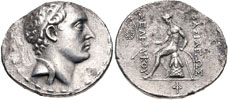 |
LAODIKE IV, wife of Seleukos IV, then of Antiochos IV, mother of Demetrios I
|
10861. SELEUCID KINGS, LAODIKE IV? Struck under Antiochos IV Epiphanes. 175-164 BC. AE (27mm, 20.22 g, 12h). 'Egyptianizing' series. Antioch mint. Struck 169-168 BC. Head of Isis right, wearing tainia / Eagle standing right on thunderbolt. SC 1414; HGC 9, 644. VF, dark grayish-green patina.
The obverse portrait of Isis which appears to be modeled on a real woman is likely that of Laodike IV the wife of Antiochos IV as Isis as the very similar coins of Ptolemy V on which this issue is modeled are thought to portray his wife Cleopatra I as Isis (see our 9372 and 9373 in the Egyptian coin section). |
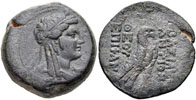 |
ANTIOCHOS, 175-170, son of Seleukos IV
|
11649. SELEUKID KINGS, ANTIOCHOS, son of Seleukos IV, 175-170 BC. AR Tetradrachm (16.51 g, ?? mm,). Antioch mint. Diademed head of the child king right / BAΣIΛEΩΣ ANTIOXOY; Apollo Delphios seated left on omphalos resting bow to ground with left hand, sighting down arrow held in right hand; torch to outer left. ΣΛ in field to left, monogram in field to right. SC 1365. VF. An extremely rare type. High relief.
On the assassination of Seleukos IV in 175 Heliodoros seized power as regent for the late king's five-year-old son, Antiochos. But Seleukos' brother, also named Antiochos, invaded Syria and made himself master of the kingdom, reigning as Antiochos IV. His young nephew disappears from history after several years of nominal joint rule. Only a few coins were struck with his portrait. Commentary adapted from David Sear's 'Greek Coins and Their Values'. |
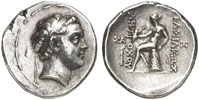 |
ANTIOCHOS IV, EPIPHANES, 175-164, younger son of Antiochos III
|
12934. SELEUKID KINGS, ANTIOCHOS IV, 175-164 BC. AR Tetradrachm (30mm, 16.58 g, 12h). Antioch on the Orontes mint. Series 3, struck 168-164 BC. Bearded head of Zeus right, wearing laurel wreath / BAΣIΛEΩΣ ANTIOXOY ΘEOY EΠIΦANOYΣ NIKEΦOPOY, Zeus Nikephoros seated left; no control marks. SC 1398; Le Rider, Antioche, Series IIIA, 225 (A22/P159) = Sunrise 195 corr. (obv. type; this coin); Morkholm Series III, 14 (A23/P94); SMA 63; HGC 9, 620a. EF, double struck on reverse. Bold portrait. Provenance: The Sunrise Collection. Ex Numismatic Fine Arts XXXII (10 June 1993), lot 95. |
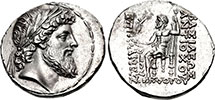 |
|
10870. SELEUKID KINGS, ANTIOCHOS IV, 175-164 BC. Tetradrachm. Antioch mint. Obv: Diademed head right. Rev: Zeus Nikephoros seated left, monogram in exergue. SC 1397a; Houghton 104; Newell, SMA 54; SNG Spaer 977. Condition: Good very fine. Weight: 16.4 gm. Diameter: 31 mm. |
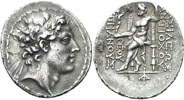 |
|
9361. SELEUKID KINGS, ANTIOCHOS IV, 175-164 BC. AE36, BMC 41, Sear 6985. Hd Zeus r./Eagle stg. l. VF+. This Antiochos destroyed the Jerusalem temple. Scarce. A choice example of exceptional style and condition. |
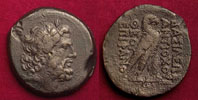
|
ANTIOCHOS V, EUPATOR, 164-162, son of Antiochos IV
|
10862. SELEUCID KINGS, ANTIOCHOS V EUPATOR. 164-162 BC. AR Tetradrachm (30mm, 16.79 g, 12h). Tarsos mint. Diademed head right / Zeus Nikephoros seated left; monogram to outer left. SC 1575.1; SMA 384; HGC 9, 751a. VF. |
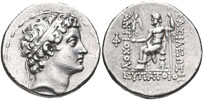 |
TIMARCHOS, 162, Satrap of Babylon, Usuper
|
10609. SELEUKID KINGS, TIMARCHOS. Usurper, 164-161 BC. AE (34mm, 34.50 g, 7h). Ekbatana mint. Diademed head right / Nike advancing left, holding wreath and palm. SC 1598; HGC 9, 769. Near VF, dark brown surfaces, some pitting, usual adjustment marks. Very rare and a superior example with a clear portrait. From the HLT Collection.
Timarchos was a close adherent of Antiochos IV, who appointed him as the Seleucid ambassador to Rome, and later as satrap of Media (or Babylonia). His brother, Herakleidas, was also an associate of the king, who appointed him as royal treasurer. Upon the death of Antiochos IV, his nephew, Demetrios (I), who was a hostage at Rome, appealed to the Romans to be made the new king. The Romans, however, looked for a weaker ruler, and supported the accession of Antiochos' child, Antiochos V. Demetrios soon escaped from Rome, and recruited a powerful army to back his bid for the Seleucid throne. Upon entering Syria, Demetrios easily took control, ordering the death of the young king, and removed Herakleidas from his position. One may assume Timarchos was also slated for removal. In late 162 or 161 BC, Timarchos appealed to the Romans for help, and they recognized him as king (though likely only over an independent Media). He quickly consolidated his rule in Media, and took the title Great King, apparently appealing to the sentiments of the native Persians to support his rule. Soon Timarchos had an army to challenge Demetrios, and he took control of Seleucia on the Tigris. Nonetheless, Demetrios' support was too strong, and Timarchos was defeated and killed in battle, probably somewhere near Babylon.
Although previous research had suggested his power base was Babylon, more recent discoveries, including the numismatic evidence, support the contention that Ekbatana was his capital. The numismatic evidence also suggests that Timarchos may have begun his revolt during the reign of Antiochos V, perhaps recognizing that the Roman candidate would obviously be unable to keep control of the kingdom while threats abounded on many fronts, including especially the ascendant Parthian kingdom of Mithridates I, to the east. Commentary courtesy CNG. |
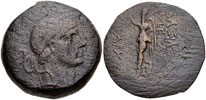
|
DEMETRIOS I, SOTER, 162-150, son of Seleukos IV
|
8583. SELEUCID KINGS, DEMETRIOS I, 162-150 BC. AR Tetradrachm, 16.79 gm. Houghton 151, Sear 7015. His diademed head r./Tyche std. l. EF. A superb finely styled example of Hellenistic portrait art much superior to most examples. |
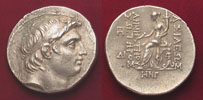 |
ALEXANDER I, BALAS, 150-145, claimed son of Antiochos IV
|
8585. SELEUCID KINGS, ALEXANDER I, BALAS, 150-145 BC. AR Tetradrachm, Tyre mint, Sear 7033v. His portrait head r./Eagle stg. on prow l., Heracles club with TYP monogram on top to l., date to r. EF. Choice example with beautifully styled Hellenistic portrait and great detail, especially on the reverse. Slightly gold iridescent tone. |
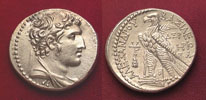 |
DEMETRIOS II, NIKATOR, first reign 145-140, elder son of Demetrios I
|
11017. SELEUCID KINGS OF SYRIA, DEMETRIOS II NIKATOR. First reign, 146-138 BC. AR Tetradrachm (28mm, 16.74 g, 2h). Antioch mint. Dated SE 167 (146/5 BC). Diademed head right / Apollo seated left on omphalos, testing arrow, resting hand on bow; IΞP (date) and monograms in exergue. SC 1906.3 = CSE 214 (this coin); HGC 9, 957d. Good VF, toned. From the Stephen Glover Collection. Ex Arthur Houghton Collection, 214. Wonderful style portrait. |
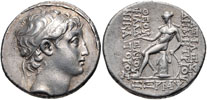 |
|
11018. SELEUCID KINGS OF SYRIA, DEMETRIOS II NIKATOR. First reign, 146-138 BC. AR Tetradrachm (30mm, 16.70 g, 1h). Antioch mint. Dated SE 167 (146/5 BC). Diademed head right / Apollo seated left on omphalos, testing arrow, resting hand on bow; palm branch to outer left, monograms to inner left, ZΞP (date) and monogram and in exergue. SC 1906.5d; HGC 9, 957d. EF, toned, a few light scratches. Excellent style portrait and a choice sharp reverse. |
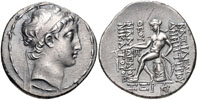 |
ANTIOCHOS VI, DIONYSOS, 145-142, infant son of Alexander Balas
|
10997. SELEUKID KINGS OF SYRIA, ANTIOCHOS VI DIONYSOS, 144-142 BC. AR Tetradrachm (31mm, 16.78 g, 12h). Antioch mint. Dated SE 170 (143/2 BC). Radiate and diademed head right / The Dioskouroi riding left, holding couched lances; to right, TPY above monogram; OP (date) below; all within wreath. SC 2000.3d; HGC 9, 1032. Good VF, lightly toned. From the Fredy Vortisch Collection. |
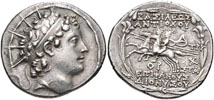 |
TRYPHON, 142-138, general and regent for Antiochos VI
|
12935. SELEUKID KINGS, TRYPHON, SELEUKID KINGS of SYRIA. Tryphon. Circa 142-138 BC. AR Tetradrachm (33mm, 16.64 g, 12h). Antioch on the Orontes mint. Diademed head right / BAΣIΛEΩΣ TPYΦΩNOΣ AYTOKPATOPΩΣ, spiked Macedonian helmet with cheek guards, adorned with wild goat's horn above visor; monogram to inner left; all within oak wreath. SC 2030a; SMA 262 (same obv. die as illustration); HGC 9, 1055; Sunrise 210A corr. (pedigree; this coin). EF, attractively toned, traces of deposits. Well struck from artistic dies. Rare. Provenance: The Sunrise Collection. Ex Numismatica Ars Classica 59 (4 April 2011), lot 649.
|
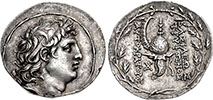
|
ANTIOCHOS VII, EUERGETES (SIDETES), 138-129, younger brother of Demetrios II
|
7205. SELEUCID KINGS, ANTIOCHOS VII, 138-129 BC. AR Tetradrachm. Head of Antiochus VII r. /Athena stg. with Nike. Choice EF. Sharp. |
 |
|
7208. SELEUCID KINGS, ANTIOCHOS VII, 138-129 BC. AR Tetradrachm. Head of Antiochus VII r. /Athena stg with Nike. Choice EF. Sharp. |
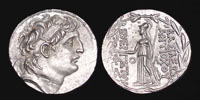 |
ANTIOCHOS EPIPHANES, Usurper 128, likely son of Antiochos VII and Cleopatra
|
11454. SELEUKID KINGS of SYRIA. ANTIOCHOS EPIPHANES. Usurper, 128 BC. AR Tetradrachm (27mm, 15.98 g, 12h). Antioch mint. Diademed head right / Tyche standing left, holding scepter and cornucopia; Σ to outer left, N in circle to inner right. Houghton & Le Rider 2 (D1/R1); SC 2208; HGC 9, 1145. VF, porous. Extremely rare.
This coinage of a young king with the name and epithet of Antiochos Epiphanes was originally attributed by Houghton & Le Rider to an ephemeral childhood reign of Antiochos VIII, under the regency of his mother, Cleopatra Thea. This attribution was challenged by K. Ehling, in "Die Nachfolgeregelung des Antiochos VII. vor seinem Aufbruch in den Parthierkrieg (131 v.Chr.)," JNG XLVI (1996), who argued that Antiochos VIII was too old for the obviously very young portrait on these coins. He thought it was also a son of Cleopatra, but from her marriage to Antiochos VII, and that it was issued in 131, at the time of Antiochos' Parthian campaign. Houghton and Lorber, in SC (forthcoming), note that the control mark linkage affirms the later date of 128 BC, and maintain that this is still an issue under Cleopatra, but perhaps of the eldest son of Antiochos VII. Of the four known tetradrachms of this Antiochos' reign, only two are available to collectors (and were sold at, respectively, Leu 28 [5 May 1981], lot 200 [realized 23000 Sfr], and Numismatic Fine Arts XVIII [31 March 1987], lot 383 [realized $8000]); the other two are in the BN and the ANS. Commentary courtesy CNG.
|
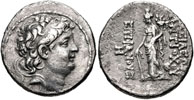 |
DEMETRIOS II, NIKATOR, second reign 129-125, elder son of Demetrios I
|
11631. SELEUKID KINGS OF SYRIA, DEMETRIOS II, NIKATOR. Second reign, 129-125 BC. AR Tetradrachm (29mm, 16.53 g, 1h). Antioch mint. Struck circa 129-128 BC. Diademed and horned head right / Zeus Nikephoros seated left; Ξ to outer left, O below throne. SC 2166.2c; HGC 9, 1117b. Good VF, flan slightly bent, edge chipped.
|
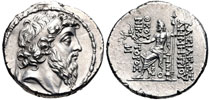 |
ALEXANDER II, ZABINAS, 128-123, claimed adopted son of Alexander Balas
|
10608. SELEUKID KINGS, ALEXANDER II ZABINAS. 128-122 BC. AR Tetradrachm (28mm, 16.33 g, 12h). Uncertain mint 113, in northern Syria or Cilicia. Diademed head right / Zeus Nikephoros seated left; two monograms to outer left, monogram below throne. SC 2214; HGC 9, 1149c. Good VF, hairline obverse die scratch. Very fine style Hellenistic portrait, much superior to most dies for this issue.
|
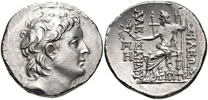
|
SELEUKOS V, 125, son of Demetrios I and Cleopatra Thea who had him murdered, doubtful if any coins were issued in his name
CLEOPATRA THEA, 125, daughter of Ptolemy VI of Egypt, successive wife of Alexander Balas, Demetrios II and Antiochos VII
|
10863. SELEUCID KINGS, CLEOPATRA THEA AND ANTIOCHOS VIII (her son). Joint reign 125-121 BC. AR Tetradrachm (28mm, 15.81 g, 12h). Antioch mint. Struck 122-121 BC(?). Jugate busts right of Cleopatra Thea, diademed, veiled, and wearing stephane, and Antiochus VIII diademed / Zeus Nikephoros seated left; IE to outer left, A below throne. SC 2262.1d; HGC 9, 1182c. VF, lightly toned, edge flakes. |
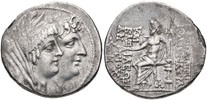 |
ANTIOCHOS VIII, GRYPOS, 121-96, son of Cleopatra Thea and Demetrios II
|
10848. SELEUCID KINGS, ANTIOCHOS VIII EPIPHANES (GRYPOS). 121/0-97/6 BC. AR Tetradrachm (26mm, 16.55 g, 12h). Antioch mint. Struck circa 121/0-113 BC. Diademed head right / Zeus Ouranios standing left; to outer left, IE above A; AI to inner right, AI in exergue; all within laurel wreath. SC 2298.2f; HGC 9, 1197e. Nice EF, toned. |
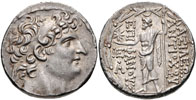
|
ANTIOCHOS IX, KYZIKENOS, 113-95, son of Antiochos VII and Cleopatra
|
10502. SELEUKID KINGS of SYRIA. ANTIOCHOS IX EUSEBES PHILOPATOR (KYZIKENOS), 114/3-95 BC. AR Tetradrachm (28mm, 16.14 g, 12h). Damaskos mint. Dated SE 202 (111/10 BC). Diademed head right / Athena Nikephoros standing left; two monograms to outer left, BΣ (date) in exergue; all within laurel wreath border. SC 2381.4; HGC 9, 1228j. Near EF.
| 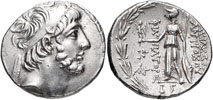 |
SELEUKOS VI, EPIPHANES NIKATOR, 95-94, eldest son of Antiochos VIII, nephew of Antiochos IX, cousin of Antiochos X
|
11624. SELEUKID KINGS of SYRIA. SELEUKOS VI EPIPHANES NIKATOR. Circa 96-94 BC. AR Tetradrachm (27mm, 16.27 g, 12h). Antioch mint. Diademed head right / Zeus Nikephoros seated left, holding lotus-tipped scepter; A/N/A to outer left, A below throne; all within wreath. SC 2415d; HGC 9, 1270. Good VF, lightly toned. Provenance: From the Demetrios Armounta Collection. |
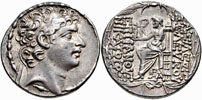
|
ANTIOCHOS X, EUSEBES PHILOPATOR, 94-83, son of Antiochos IX
|
11019. SELEUKID KINGS of SYRIA. ANTIOCHOS X EUSEBES PHILOPATOR. Circa 94-88 BC. AR Tetradrachm (27mm, 16.09 g, 1h). Antioch mint. Diademed head right / Zeus Nikephoros seated left; monograms to outer left and below throne. SC 2434.1; HGC 9, 1288. Good VF, toned. From the Stephen Glover Collection. Choice example. |
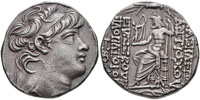
|
ANTIOCHOS XI, EPIPHANES PHILADELPHOS, 93, son of Antiochos VIII, brother of Philip, cousin of Antiochos X, younger brother of Seleukos VI
DEMETRIOS III, PHILOPATOR, 95-88, son of Antiochos VIII, brother of Philip, cousin of Antiochos X
|
10849. SELEUCID KINGS, DEMETRIOS III EUKAIROS. 97/6-88/7 BC. AR Tetradrachm (28mm, 15.64 g, 12h). Damaskos mint. Dated SE 216 (97/6 BC). Diademed head right / Cult statue of Atargatis facing; to outer left, monogram above Ξ; cIe (date) and monogram in exergue. SC 2450.1; HGC 9, 1305. VF, toned. |
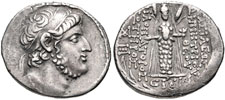
|
PHILIP PHILADELPHOS, 93-83, son of Antiochos VIII
|
10520. SELEUCID KINGS, PHILIP PHILADELPHOS, 93-83 BC. AR Tetradrachm. Size 26 mm. weight 15.87 gm. Obverse: His diademed head r. withing fillet border. Reverse: Zeus enthroned holding Nike and Scepter within wreath. Near EF. |
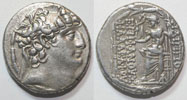
|
ANTIOCHOS XII, DIONYSOS, 88-84, youngest of the 5 sons of Antiochos VIII, brother of Demetrios III, brother of Philip
|
11690. SELEUCID KINGS, ANTIOCHOS XII DIONYSOS. 87/6-83/2 BC. AR Tetradrachm (28mm, 15.37 g, 12h). Damaskos mint. Dated SE 226 (87/6 BC). Diademed head right / Cult image of Hadad, holding grain ear, standing facing on double basis; two bull foreparts flanking legs; monogram and date in exergue. SC 2471.2; HHV 2-4 var. (unlisted dies); HGC 9, 1324; DCA 309. VF, toned, some porosity, a few scratches. Extremely rare, one of only four examples known for this date, two of which are in public collections (BM and BN).
|
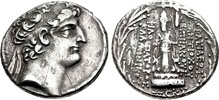
|
TIGRANES II OF ARMENIA, 83-69
|
11439. SELEUCID KINGS, TIGRANES II, The Great, of Armenia, 95-56 BC. AR Tetradrachm (27mm, 15.63 g, 12h). Antioch mint. Diademed and draped bust right, wearing tiara / Tyche seated right, holding laurel branch; at feet, half-length figure of the river-god Orontes swimming right; monogram to inner right and on rock; all within wreath. SCADA Group 1, dies A8/P Ð; CAA 17; AC 31. Near VF, toned.
In 83 BC the Syrians, wearied by the endless fratricidal wars of the Seleukids, called upon Tigranes II, the King of Armenia, to restore order in their country. He defeated Philip and ruled the Syrian kingdom for the following fourteen years, issuing coins on the Seleukid pattern. Eventually he was driven out of Syria by the Roman general Lucullus.
|
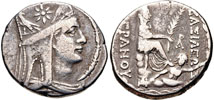
|
ANTIOCHOS XIII, ASIATIKOS, 69-64, son of Antiochos X
ROMAN PROVINCE OF SYRIA, after 63 BC
|
12948. SYRIA, ROMAN PROVINCE OF, Seleucis and Pieria. Antioch. Aulus Gabinius. Proconsul, 57-55 BC. AR Tetradrachm (24mm, 15.20 g, 12h). Posthumous Philip I Philadelphos type. Diademed head of Philip right / Zeus Nikephoros seated left on throne; monogram of Gabinius to inner left, monogram below throne; all within wreath. SC 2489.1; Prieur 1; RPC I 4124. VF, porous. Excellent example of these last Seleucid type tetradrachms after the conquest by the Romans. A handsome piece with much better style than usual. Scarce.
|
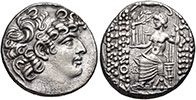 |
SYRIA
|
9393. SYRIA, SELEUKIS AND PIERIA, SELEUKEIA, after 109/108 BC. AR Tetradrachm. Veiled and turreted bust of Tyche r./Thunderbolt with fillet, on cushion placed on stool. EF. Quite scarce. |
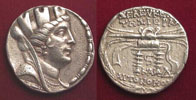
|

































































